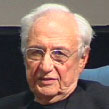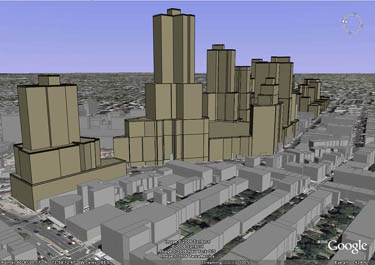 Starchitect Frank Gehry surely has put his foot in his mouth during discussions of the Atlantic Yards project, notably in May when he cracked that critics should've been "picketing Henry Ford" or last January when he misdescribed the footprint as "an empty site."
Starchitect Frank Gehry surely has put his foot in his mouth during discussions of the Atlantic Yards project, notably in May when he cracked that critics should've been "picketing Henry Ford" or last January when he misdescribed the footprint as "an empty site."But Gehry didn't quite say, as he's been quoted, that he had the opportunity "to build a neighborhood from scratch." The press reported that, but Gehry actually said "practically from scratch."
(Emphasis added)
Meaningful? Slightly--but worth correcting for the record.
Brooklyn's spaceship
 Then again, maybe we should concentrate on the notion of neighborhood. As the Park Slope Civic Council testified:
Then again, maybe we should concentrate on the notion of neighborhood. As the Park Slope Civic Council testified:The development plan will not create a neighborhood, but rather a high-density enclave between several neighborhoods which will in fact be a new urban form, however, more likely analogous to a spaceship landing in a field than a unifying element in the community (see scaled depiction below). It may work in concert with itself but not with the surrounding neighborhoods.
(Graphic from the Environmental Simulation Center for the Council of Brooklyn Neighborhoods. Three buildings have since been reduced.)
Gehry's quote
A 12/11/03 New York Times article, headlined A Grand Plan in Brooklyn for the Nets' Arena Complex contained this passage:
Mr. Gehry, who designed the Guggenheim Museum in Bilbao, Spain, and the Mighty Ducks hockey training facility in Anaheim, Calif., said he had never had an opportunity "to build a neighborhood from scratch in an urban setting."
I just watched footage from the 12/10/03 press conference announcing the Atlantic Yards project. (Go to this list and find the December 10 "Economic Development Announcement.")
Gehry said:
This is an extraordinary opportunity for an architect like me, I’ve been doing these iconic buildings, like Disney Hall and the Bilbao museum, but not an opportunity like this, to do housing, to do a mixed project and build a whole neighborhood practically from scratch and fit it into an existing fabric and make something special out of it. Also, the opportunity to build an arena in a very urban setting, which is unique-- most of them are built out in the fields, where there’s lots of parking around them. This has a different character, and we’re trying to understand it and work with that.
(Emphasis added)
Gehry vs. ESDC
It's all relative, right? Gehry has actually been more candid than the Empire State Development Corporation, which in the Final Environmental Impact Statement (FEIS), relies on generalities:
The density of the proposed project is consistent with, but generally less than, the densities employed throughout the city for areas surrounding concentrations of mass transit.
Gehry, on the other hand, acknowledged in January:
I think the scale issue is the only problem, we're out of whack with that.
Gehry, Liu, Lethem
But the rub is that Gehry must first answer to his client. There's an interesting exchange of letters in the journal n+1 about Gehry and Atlantic Yards.
Jonathan Liu had defended Atlantic Yards, criticizing author Jonathan Lethem (whose open letter to Gehry in Slate, as did I, used the "neighborhood from scratch" quote).
Liu wrote:
The authenticity of a place as volatile and heterodox as Brooklyn, and New York in general, lies in incongruity, the disorienting juxtaposition of century-old brownstones and Gehry’s warped, twisting towers.... But to reject it outright, to reject any such impulse as a disruption of some putatively authentic civic reality, to reject Gehry on the basis of “context,” seems a disavowal of the progress of urban life itself.
Lethem responded, in part:
A thousand different futures could be projected for that zone (and if you chose from a thousand at random you could hardly do worse than Ratner's top-heavy, over-dense, privatized, underplanned, compromised-yet-railroaded vision).
Liu countered:
The fact is, there are a thousand different futures possible in that zone, and Mr. Lethem and the opposition could steer the city toward any number of them if they held their collective nose and negotiated directly with the developer, demanding, say, truly affordable housing or at least a semblance of public oversight...
As it's unlikely that an entirely acceptable development (say, a commune) will go up in central Brooklyn anytime soon, why not engage in the process and ask Frank Gehry, a fellow artist, for better?
Except that there was little to negotiate once the city and state lined up behind Atlantic Yards. As for meeting with community residents, Gehry has said he's willing, "as soon as the guys let me," referring to developer Forest City Ratner.
They haven't.
Comments
Post a Comment